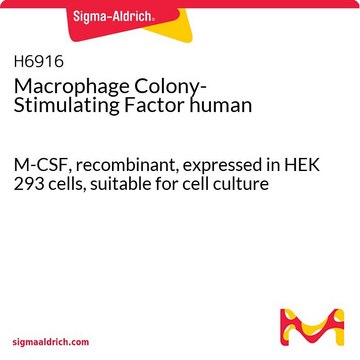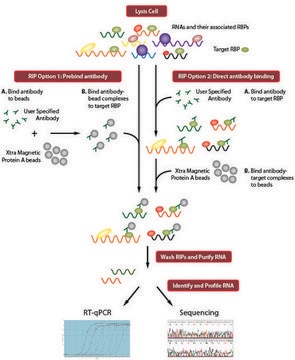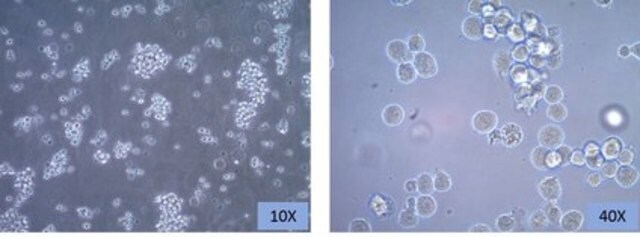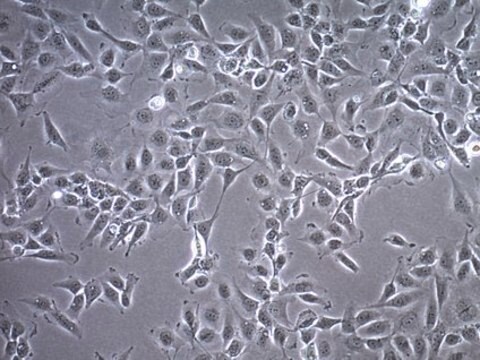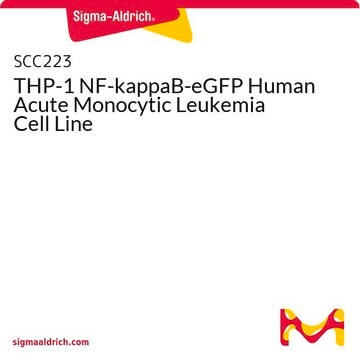SCC165
BLaER1 Human B-cell Precursor Leukemia Cell Line
Human
Sinônimo(s):
B cell Leukemia C/EBPalphaER clone 1
About This Item
Produtos recomendados
Nome do produto
BLaER1 Human B-cell Precursor Leukemia Cell Line, BLaER1 human B-cell precursor leukemia cell line may be transdifferentiated and used to model human monocytes.
fonte biológica
human
técnica(s)
cell culture | mammalian: suitable
Condições de expedição
ambient
Descrição geral
The BLaER1 cell line is a tamoxifen-inducible derivative of the RCH-ACV B-cell leukemia cell line genetically modified using a retrovirus vector to express C/EBPa fused with the estrogen receptor hormone binding domain (ER) and GFP . A study demonstrated that BLaER1 cells could efficiently convert into cells exhibiting increased adherent, phagocytic and quiescent properties with a transcriptome resembling normal macrophages . Cells retained their phenotype even when C/EBPa was inactivated, a characteristic of genuine cell reprogramming. C/EBPa induction also impaired cell tumorigenicity after transplantation into immunodeficient mice. BLaER1 is thus a model for highly efficient transdifferentiation of B-cell-derived human cancer cells.
Source:
BLaER1 cells are a single subclone isolated from C/EBPaER-GFP-transfected RCH-ACV acute lymphoblastic leukemia (ALL) cells sorted for GFP expression. The parental cell line was obtained from the bone marrow of a female with chromosome translocation 1;19 and trisomy 8 .
Biosafety Level 2:
BLaER1 cells contain squirrel monkey retrovirus (SMRV) and should be handled under biosafety level 2.
Descrição de linhagem celular
Aplicação
Qualidade
- Each vial contains ≥1×10 viable cells.
- Cells are tested negative for infectious diseases by a Human Essential CLEAR panel by Charles River Animal Diagnostic Services.
- Cells are verified to be of human origin and negative for inter-species contamination from mouse, rat, chinese hamster, Golden Syrian hamster, and non-human primate (NHP) as assessed by a Contamination Clear panel by Charles River Animal Diagnostic Services
- Cells are negative for mycoplasma contamination.
- Cells tested positive for squirrel monkey retrovirus (SMRV).
Armazenamento e estabilidade
Palavra indicadora
Warning
Frases de perigo
Declarações de precaução
Classificações de perigo
Skin Sens. 1
Código de classe de armazenamento
12 - Non Combustible Liquids
Classe de risco de água (WGK)
WGK 1
Ponto de fulgor (°F)
Not applicable
Ponto de fulgor (°C)
Not applicable
Certificados de análise (COA)
Busque Certificados de análise (COA) digitando o Número do Lote do produto. Os números de lote e remessa podem ser encontrados no rótulo de um produto após a palavra “Lot” ou “Batch”.
Já possui este produto?
Encontre a documentação dos produtos que você adquiriu recentemente na biblioteca de documentos.
Nossa equipe de cientistas tem experiência em todas as áreas de pesquisa, incluindo Life Sciences, ciência de materiais, síntese química, cromatografia, química analítica e muitas outras.
Entre em contato com a assistência técnica
